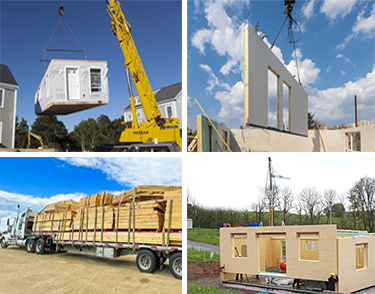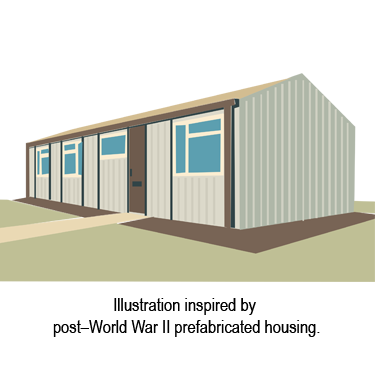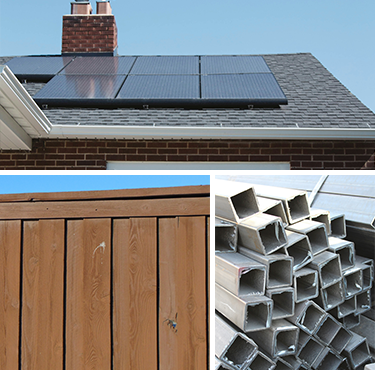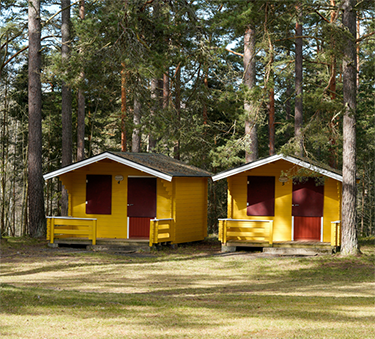Prefab, short for prefabricated, homes are changing the way we think about housing. These homes are built in factories in parts or modules, then transported to a site and assembled like building blocks. This modern construction method saves time, reduces waste, and allows for more creative and efficient designs. As housing shortages rise around the world and sustainability becomes increasingly important, prefab homes offer a practical and eco-friendly solution. Today, countries like Sweden, Japan, and the U.S. are leading this housing revolution, showing how innovation can reshape the way we live.
Activity 1 – What are Prefab homes?

Prefab homes are built in controlled factory environments, where walls, floors, and roofs are made with precision and then assembled on-site. This process can reduce construction time by up to 50% and cut waste by nearly 70% compared to traditional house building. There are several types of prefab homes, such as modular homes (built in sections), panelized homes (flat panels assembled on-site), and fully manufactured homes (built almost entirely in the factory). Prefab homes often meet or exceed building codes, offering durability, efficiency, sustainability, and modern design.
Why do you think building homes in factories can help solve housing shortages?
Activity 2 – The History of Prefab Homes

The concept of prefabrication is centuries old. In the 1600s, English settlers shipped ready-to-build house parts to North America. By the 1800s, companies were selling “kit homes” that could be ordered by mail and assembled by the owner. Sears sold more than 70,000 of these homes between 1908 and 1940. After World War II, prefab homes became popular again as returning soldiers needed affordable housing. Today, with advanced technology and design, prefab homes are not only economical but also sustainable, attractive, and customizable.
How did history and technology shape the way prefab homes are built today?
Activity 3 – Types of Prefab Homes

Prefab homes come in many styles and levels of completion.
Modular homes are built in large, box-like sections —such as kitchens and bathrooms —that are transported and joined together on-site; they can be one- or multi-story.
Panelized homes are shipped as flat walls, floors, and roof panels that are assembled quickly on-site, making them ideal for remote or tight areas.
Manufactured homes, formerly known as mobile homes, are built almost entirely in factories and placed on a foundation or movable frame. These homes are towed or delivered to sites.
Container homes, made from recycled shipping containers, are popular for their strength, affordability, and industrial aesthetic. Some companies are even experimenting with [3D-printed homes], built layer by layer using robotic printers that can complete a house in less than 24 hours.
Each type has its own advantages, depending on climate, location, and lifestyle needs.
Choose a type of prefab home that interests you most, and draw it!
Activity 4 – Materials and Sustainability

Prefab homes often use strong, yet lightweight materials, such as steel, engineered wood, bamboo, or recycled composites. Because they are built indoors, factories can reuse materials and control waste much more efficiently. Many prefab homes come with solar panels, green roofs, and smart energy systems that reduce electricity use by up to 30%. Building in factories also means less noise and pollution at the construction site. Prefab housing supports the global move toward net-zero carbon emissions by using renewable materials and efficient designs.
What eco-friendly features would you include if you could design your own prefab home?
Activity 5 – Prefab Homes Around the World

Around the globe, prefab homes are becoming a preferred housing solution.
In Sweden, more than 80% of new single-family homes are prefabricated, combining modern design with energy efficiency.
In Japan, precision-engineered prefab houses are designed to resist earthquakes and last for decades.
Germany is famous for its energy-efficient “Passivhaus” standards, while in the United States, companies like Blu Homes and Boxabl are creating customizable and affordable models. Prefab homes are also being used for disaster relief in regions hit by earthquakes and floods.
What can different countries learn from each other’s prefab home innovations?
Activity 6 – Prefab vs. Traditional Homes

Prefab homes can be built in weeks instead of months, often at 20–40% lower cost than traditional homes. Because factories build components with precision, quality control is higher, and weather delays are eliminated. Modern prefab homes can also be customized with various designs, from small eco-cabins to luxury villas. However, challenges remain; transporting large sections can be costly, and zoning laws sometimes make prefab construction harder. Despite this, the growing demand for efficient and affordable housing continues to push prefab homes forward.
What do you think stops more people from choosing prefab homes today?
Activity 7 – Design and Innovation in Prefab

Today’s prefab homes aren’t just about efficiency; they’re also about design and creativity. Architects around the world are using modular systems to create homes that are flexible, beautiful, and sustainable. Some designs can expand or shrink as families grow or change. Prefab houses can even be stacked or arranged to form apartment buildings, schools, or community centers. Advances in digital modeling and robotic construction allow architects to design custom homes that are built faster and more accurately than ever before.
If you could design a prefab home in your neighborhood, what shape or layout would you choose to make it unique?
Activity 8 – Prefab Housing for the Future

As the world faces challenges like climate change, rising housing costs, and urban overcrowding, prefab homes could become a key part of the solution. Entire modular cities are being planned in Asia and Europe, with smart systems that use local renewable energy, recycle water, and reduce waste. Prefab construction is also helping build emergency shelters, student housing, and affordable homes in developing countries. In the near future, we may see prefab homes built by 3D printers, powered by solar or wind energy, and designed for off-grid living.
A classic example is the Nakagin Capsule Tower (Tokyo, Japan, 1972), where factory-made capsules were attached to building cores, showing how housing could be assembled quickly and replaced over time. It was used as compact living and work pods, mainly for single professionals/commuters who needed a small place to stay near central Tokyo, proving how prefab can support dense urban life with minimal space.
Draw a city of the future with prefab buildings.
Review
- Prefab homes are built in controlled factory environments and can reduce construction time by up to 50%.
- The idea of prefabrication started only in the 1900s with Sears kit homes.
- Container homes are made from recycled shipping containers and are known for their strength and affordability.
- Prefab homes are usually built outdoors, which causes more waste and noise.
- More than 80% of new single-family homes in Sweden are prefabricated.
- Prefab homes generally take longer to build than traditional homes.
- Some modern prefab homes can expand or shrink depending on family needs.
- Future prefab homes may be built by 3D printers and designed for off-grid living.
Explore
- A QUALITATIVE STUDY OF THE SUSTAINABILITY OF PREFABRICATED BUILDINGS
- Guide to Prefabricated Homes
- Kieran Timberlake OPENHOME
- Kit Houses in Virginia
- Lazor Office Flat Pak Homes
- Modular Building Overview and Benefits
- Modular vs. Prefab Homes
- Overview of Prefab Homes
- Prefab House Videos
- Prefabricated&Modularized Residential Construction: A Review of Status, Opportunities, and Future Challenges
- Ralston Architects
- Ray Kappe Architects
- Sustainability of Modular Construction
- Threshold effect study on development of prefabricated buildings for energy conservation
- Timberlane Barn & Home Kits shipped your way!
- Timberlane Commercial
- Video of Prefab House being constructed
- What is a Manufactured Home?
- What Sweden and Japan can teach US about Housing


















































